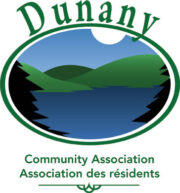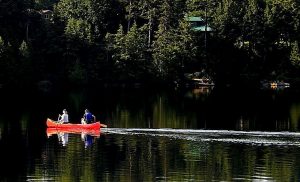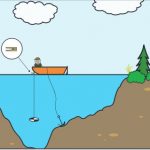Two years ago, my report on the state of our lakes bore this title
Our 2017 lake results: are they too good to be believed?
I now have the definite answer to my question. The answer is yes, they were!
In the coming months, the Quebec Department of Environment which manages the lake program (RSVL) will review the phosphorus data from year 2009, when numbers suddenly dropped in most lakes, to 2017 using data from special samples collected last summer.
So, why were the phosphorus results underestimated? After multiple investigations, the Ministry found three causes: the use of plastic bottle (now replaced by glass container), the size of the sample used at the lab (too small) and the influence of certain chlorides (now corrected at the lab). The methodology was also reviewed and improved.
Our 2019 Results
Which brings me to the latest data which is more realistic and will not be comparable to previous years.
The results are still good. Phosphorus levels, measured in micrograms/litre, are higher than previous years, maybe a bit uncomfortable, but not worrying. Black 4.6, Boyd 6.6 and Curran 4.7 and Clear at 4.2 at mcg/litre are all in the oligotrophic category.
You will find the Lake Charts here.
About Boyd Lake.
Now a few word about phosphorus concentration in Boyd Lake. Your chart shows 5, 3.7 and a spike of 11 mcg/litre of phosphorus. Why is that?
Boyd is a small lake with a very high replenishment rate. About 6 months compared to almost 2 years for the other lakes. Consequently, nutrients that go into the lake have less time to settle to the bottom. That explains higher concentrations of phosphorus at certain times like on August 18 2019 when the concentration reached 11 mg/litre. This also happened in 2007 when we measured 9.2 mcg/litre.
This higher concentration of phosphorus can also be due to zooplankton captured in the sample or other variables such as weather and runoff. This is why numbers vary a lot from 5 to 3.7 to 11 mcg/litre for a 6.6 mcg/litre 2019 average.
The average is the important number and that is why we sample three times a year.
Bottom Line.
Should we take exceptional measures to protect our lakes. Not really, but we should absolutely make sure that every septic system is in top shape, that sources of run off are eliminated and that shoreline protection bands are robust. These rules are spelled out very clearly in the Living in Dunany document. If you need help or advice, call us.
What’s in store for 2020?
Now how about water sampling in 2020? As I write this, everything is on hold. We should be able to measure clarity during the summer months but I doubt very much there will be a sampling program in those COVID-19 times.
Finally, heartfelt thanks go to our friendly volunteers who make this program possible. Jim and Lois Finch on Black, Rick Havill and Bonnie Swaine on Boyd, Sheryl Jackson Caron on Curran and François Côté and Simon Octeau on Clear.
Do not hesitate to use the comment section to forward me any question you might have about our environment.
- Hashtag is a word or phrase preceded by a hash sign (#), used on social media websites and applications, especially Twitter, to identify messages on a specific topic.



Merci Jacques, for all the great work you do for the community. This is good news but we must continue to be vigilant and protect these very valuable resources. Salutations, Barbara and Neil Hindle
Merci Jacques for all the time and attention dedicated to keeping our lakes in such good health
Thank you to all involved in the RSVL program. Cheers
Merci Jacques for that clear & timely info.
We all need some good news & a reminder to look forward to enjoying our beautiful lakes again this summer when we are out of lock-down (or at least a milder version of it…)